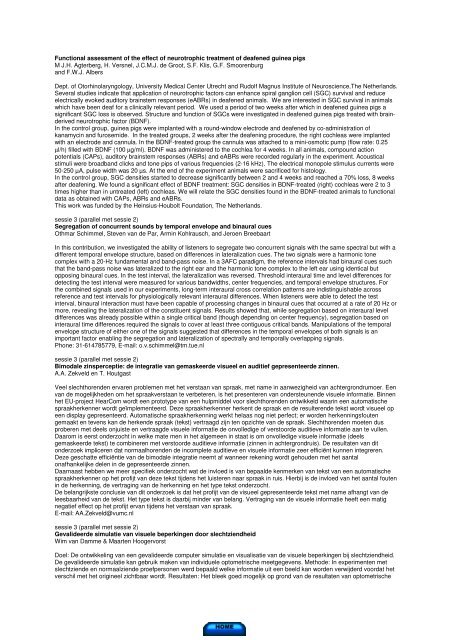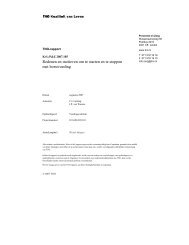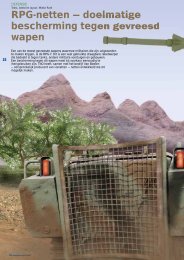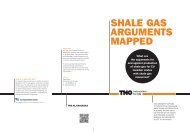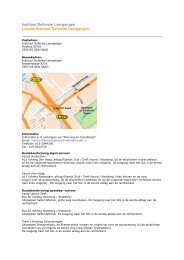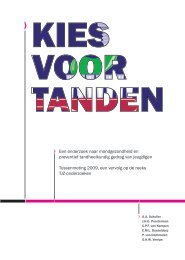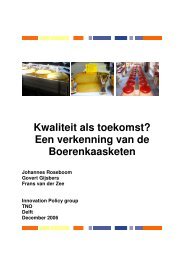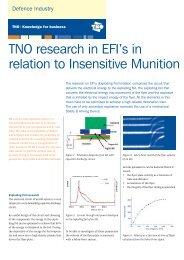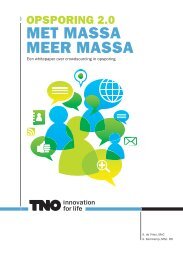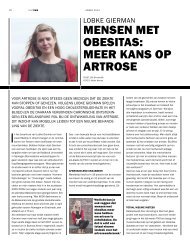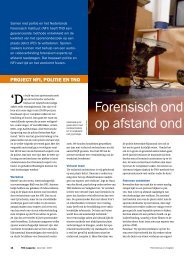Dag van de Perceptie - TNO
Dag van de Perceptie - TNO
Dag van de Perceptie - TNO
Create successful ePaper yourself
Turn your PDF publications into a flip-book with our unique Google optimized e-Paper software.
Functional assessment of the effect of neurotrophic treatment of <strong>de</strong>afened guinea pigs<br />
M J.H. Agterberg, H. Versnel, J.C.M.J. <strong>de</strong> Groot, S.F. Klis, G.F. Smoorenburg<br />
and F.W.J. Albers<br />
Dept. of Otorhinolaryngology, University Medical Center Utrecht and Rudolf Magnus Institute of Neuroscience,The Netherlands.<br />
Several studies indicate that application of neurotrophic factors can enhance spiral ganglion cell (SGC) survival and reduce<br />
electrically evoked auditory brainstem responses (eABRs) in <strong>de</strong>afened animals. We are interested in SGC survival in animals<br />
which have been <strong>de</strong>af for a clinically rele<strong>van</strong>t period. We used a period of two weeks after which in <strong>de</strong>afened guinea pigs a<br />
significant SGC loss is observed. Structure and function of SGCs were investigated in <strong>de</strong>afened guinea pigs treated with brain<strong>de</strong>rived<br />
neurotrophic factor (BDNF).<br />
In the control group, guinea pigs were implanted with a round-window electro<strong>de</strong> and <strong>de</strong>afened by co-administration of<br />
kanamycin and furosemi<strong>de</strong>. In the treated groups, 2 weeks after the <strong>de</strong>afening procedure, the right cochleas were implanted<br />
with an electro<strong>de</strong> and cannula. In the BDNF-treated group the cannula was attached to a mini-osmotic pump (flow rate: 0.25<br />
µl/h) filled with BDNF (100 µg/ml). BDNF was administered to the cochlea for 4 weeks. In all animals, compound action<br />
potentials (CAPs), auditory brainstem responses (ABRs) and eABRs were recor<strong>de</strong>d regularly in the experiment. Acoustical<br />
stimuli were broadband clicks and tone pips of various frequencies (2-16 kHz). The electrical monopole stimulus currents were<br />
50-250 µA, pulse width was 20 µs. At the end of the experiment animals were sacrificed for histology.<br />
In the control group, SGC <strong>de</strong>nsities started to <strong>de</strong>crease significantly between 2 and 4 weeks and reached a 70% loss, 8 weeks<br />
after <strong>de</strong>afening. We found a significant effect of BDNF treatment: SGC <strong>de</strong>nsities in BDNF-treated (right) cochleas were 2 to 3<br />
times higher than in untreated (left) cochleas. We will relate the SGC <strong>de</strong>nsities found in the BDNF-treated animals to functional<br />
data as obtained with CAPs, ABRs and eABRs.<br />
This work was fun<strong>de</strong>d by the Heinsius-Houbolt Foundation, The Netherlands.<br />
sessie 3 (parallel met sessie 2)<br />
Segregation of concurrent sounds by temporal envelope and binaural cues<br />
Othmar Schimmel, Steven <strong>van</strong> <strong>de</strong> Par, Armin Kohlrausch, and Jeroen Breebaart<br />
In this contribution, we investigated the ability of listeners to segregate two concurrent signals with the same spectral but with a<br />
different temporal envelope structure, based on differences in lateralization cues. The two signals were a harmonic tone<br />
complex with a 20-Hz fundamental and band-pass noise. In a 3AFC paradigm, the reference intervals had binaural cues such<br />
that the band-pass noise was lateralized to the right ear and the harmonic tone complex to the left ear using i<strong>de</strong>ntical but<br />
opposing binaural cues. In the test interval, the lateralization was reversed. Threshold interaural time and level differences for<br />
<strong>de</strong>tecting the test interval were measured for various bandwidths, center frequencies, and temporal envelope structures. For<br />
the combined signals used in our experiments, long-term interaural cross correlation patterns are indistinguishable across<br />
reference and test intervals for physiologically rele<strong>van</strong>t interaural differences. When listeners were able to <strong>de</strong>tect the test<br />
interval, binaural interaction must have been capable of processing changes in binaural cues that occurred at a rate of 20 Hz or<br />
more, revealing the lateralization of the constituent signals. Results showed that, while segregation based on interaural level<br />
differences was already possible within a single critical band (though <strong>de</strong>pending on center frequency), segregation based on<br />
interaural time differences required the signals to cover at least three contiguous critical bands. Manipulations of the temporal<br />
envelope structure of either one of the signals suggested that differences in the temporal envelopes of both signals is an<br />
important factor enabling the segregation and lateralization of spectrally and temporally overlapping signals.<br />
Phone: 31-614785779, E-mail: o.v.schimmel@tm.tue.nl<br />
sessie 3 (parallel met sessie 2)<br />
Bimodale zinsperceptie: <strong>de</strong> integratie <strong>van</strong> gemaskeer<strong>de</strong> visueel en auditief gepresenteer<strong>de</strong> zinnen.<br />
A.A. Zekveld en T. Houtgast<br />
Veel slechthoren<strong>de</strong>n ervaren problemen met het verstaan <strong>van</strong> spraak, met name in aanwezigheid <strong>van</strong> achtergrondrumoer. Een<br />
<strong>van</strong> <strong>de</strong> mogelijkhe<strong>de</strong>n om het spraakverstaan te verbeteren, is het presenteren <strong>van</strong> on<strong>de</strong>rsteunen<strong>de</strong> visuele informatie. Binnen<br />
het EU-project HearCom wordt een prototype <strong>van</strong> een hulpmid<strong>de</strong>l voor slechthoren<strong>de</strong>n ontwikkeld waarin een automatische<br />
spraakherkenner wordt geïmplementeerd. Deze spraakherkenner herkent <strong>de</strong> spraak en <strong>de</strong> resulteren<strong>de</strong> tekst wordt visueel op<br />
een display gepresenteerd. Automatische spraakherkenning werkt helaas nog niet perfect; er wor<strong>de</strong>n herkenningsfouten<br />
gemaakt en tevens kan <strong>de</strong> herken<strong>de</strong> spraak (tekst) vertraagd zijn ten opzichte <strong>van</strong> <strong>de</strong> spraak. Slechthoren<strong>de</strong>n moeten dus<br />
proberen met <strong>de</strong>els onjuiste en vertraag<strong>de</strong> visuele informatie <strong>de</strong> onvolledige of verstoor<strong>de</strong> auditieve informatie aan te vullen.<br />
Daarom is eerst on<strong>de</strong>rzocht in welke mate men in het algemeen in staat is om onvolledige visuele informatie (<strong>de</strong>els<br />
gemaskeer<strong>de</strong> tekst) te combineren met verstoor<strong>de</strong> auditieve informatie (zinnen in achtergrondruis). De resultaten <strong>van</strong> dit<br />
on<strong>de</strong>rzoek impliceren dat normaalhoren<strong>de</strong>n <strong>de</strong> incomplete auditieve en visuele informatie zeer efficiënt kunnen integreren.<br />
Deze geschatte efficiëntie <strong>van</strong> <strong>de</strong> bimodale integratie neemt af wanneer rekening wordt gehou<strong>de</strong>n met het aantal<br />
onafhankelijke <strong>de</strong>len in <strong>de</strong> gepresenteer<strong>de</strong> zinnen.<br />
Daarnaast hebben we meer specifiek on<strong>de</strong>rzocht wat <strong>de</strong> invloed is <strong>van</strong> bepaal<strong>de</strong> kenmerken <strong>van</strong> tekst <strong>van</strong> een automatische<br />
spraakherkenner op het profijt <strong>van</strong> <strong>de</strong>ze tekst tij<strong>de</strong>ns het luisteren naar spraak in ruis. Hierbij is <strong>de</strong> invloed <strong>van</strong> het aantal fouten<br />
in <strong>de</strong> herkenning, <strong>de</strong> vertraging <strong>van</strong> <strong>de</strong> herkenning en het type tekst on<strong>de</strong>rzocht.<br />
De belangrijkste conclusie <strong>van</strong> dit on<strong>de</strong>rzoek is dat het profijt <strong>van</strong> <strong>de</strong> visueel gepresenteer<strong>de</strong> tekst met name afhangt <strong>van</strong> <strong>de</strong><br />
leesbaarheid <strong>van</strong> <strong>de</strong> tekst. Het type tekst is daarbij min<strong>de</strong>r <strong>van</strong> belang. Vertraging <strong>van</strong> <strong>de</strong> visuele informatie heeft een matig<br />
negatief effect op het profijt er<strong>van</strong> tij<strong>de</strong>ns het verstaan <strong>van</strong> spraak.<br />
E-mail: AA.Zekveld@vumc.nl<br />
sessie 3 (parallel met sessie 2)<br />
Gevali<strong>de</strong>er<strong>de</strong> simulatie <strong>van</strong> visuele beperkingen door slechtziendheid<br />
Wim <strong>van</strong> Damme & Maarten Hoogervorst<br />
Doel: De ontwikkeling <strong>van</strong> een gevali<strong>de</strong>er<strong>de</strong> computer simulatie en visualisatie <strong>van</strong> <strong>de</strong> visuele beperkingen bij slechtziendheid.<br />
De gevali<strong>de</strong>er<strong>de</strong> simulatie kan gebruik maken <strong>van</strong> individuele optometrische meetgegevens. Metho<strong>de</strong>: In experimenten met<br />
slechtzien<strong>de</strong> en normaalzien<strong>de</strong> proefpersonen werd bepaald welke informatie uit een beeld kan wor<strong>de</strong>n verwij<strong>de</strong>rd voordat het<br />
verschil met het origineel zichtbaar wordt. Resultaten: Het bleek goed mogelijk op grond <strong>van</strong> <strong>de</strong> resultaten <strong>van</strong> optometrische


